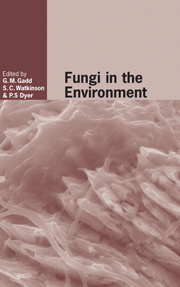Book contents
- Frontmatter
- Contents
- List of contributors
- Preface
- I Imaging and modelling of fungi in the environment
- II Functional ecology of saprotrophic fungi
- 5 Mineral transformations and biogeochemical cycles: a geomycological perspective
- 6 Mycelial responses in heterogeneous environments: parallels with macroorganisms
- 7 Natural abundance of 15N and 13C in saprotrophic fungi: what can they tell us?
- III Mutualistic interactions in the environment
- IV Pathogenic interactions in the environment
- V Environmental population genetics of fungi
- VI Molecular ecology of fungi in the environment
- Index
- References
7 - Natural abundance of 15N and 13C in saprotrophic fungi: what can they tell us?
from II - Functional ecology of saprotrophic fungi
Published online by Cambridge University Press: 03 November 2009
- Frontmatter
- Contents
- List of contributors
- Preface
- I Imaging and modelling of fungi in the environment
- II Functional ecology of saprotrophic fungi
- 5 Mineral transformations and biogeochemical cycles: a geomycological perspective
- 6 Mycelial responses in heterogeneous environments: parallels with macroorganisms
- 7 Natural abundance of 15N and 13C in saprotrophic fungi: what can they tell us?
- III Mutualistic interactions in the environment
- IV Pathogenic interactions in the environment
- V Environmental population genetics of fungi
- VI Molecular ecology of fungi in the environment
- Index
- References
Summary
Introduction
The aim of this chapter is to summarize recent developments in the study of the natural abundance of stable isotopes, primarily 15N and 13C, in fungal sporocarps. The main focus will be on saprotrophic fungi but, owing to a scarcity of studies, considerable use is made of the more abundant literature on ectomycorrhizal fungi. A brief introduction to the terminology used in the determination and use of the stable isotopes 15N and 13C is provided. This is followed by a discussion of the most significant findings from investigations into ectomycorrhizal fungi and how these compare with the available data from saprotrophic fungi. Recent results from a study focusing on saprotrophic fungi are then presented. Finally, some suggestions are given as to where isotope data may be useful in investigating the ecology of saprotrophic fungi.
Microorganisms are integral components of most biogeochemical cycles in terrestrial ecosystems (Dighton, 1995). The role of fungi, in particular, in boreal and temperate forests is pivotal. Most of the trees in these forests form mutualistic associations with a wide range of ectomycorrhizal fungi (Smith & Read, 1997) while the breakdown of woody debris is almost exclusively carried out by saprotrophic fungi (Tanesaka et al., 1993). In addition to these essential ecological roles, fungi make up a large proportion of the total organism diversity in these systems. Despite their evident importance, relatively little is known about fungal activities in situ.
- Type
- Chapter
- Information
- Fungi in the Environment , pp. 141 - 158Publisher: Cambridge University PressPrint publication year: 2007
References
- 3
- Cited by



